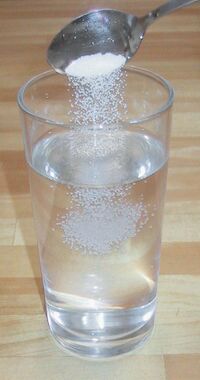Salt rinse
Topic: Medicine
 From HandWiki - Reading time: 3 min
From HandWiki - Reading time: 3 min
Salt rinse is a saline solution mouthwash used in dentistry to treat certain diseases and reduce post-operative pain and infection. It is also offered commercially for routine oral hygiene.[1] Other names for the treatment include salt water mouthwash,[2] salt water mouth bath,[3] and saline mouth rinse.[4]
Preparation and Use
There appears to be no standard for preparation and use of a salt rinse in dentistry.
Solution. Descriptions of the solution mixture include “one level teaspoon of salt in a glass of warm water,”[4] "about 1/2 teaspoon (2.5 milliliters) of salt in 1 cup (237 milliliters) of warm water,"[5] “one teaspoonful of common salt in a domestic tumbler.”[6] and 0.5–1 teaspoon of table salt into a cup of water.[7][8][9]
Temperature. "Warm,"[4] "hot,”[2] and "a temperature as would be taken for a fresh cup of tea" (producing a solution roughly isotonic with body tissues).[6]
Duration. "Gargle,"[4] "swish",[5] "rinse ... for 30 seconds,[1]" and "retain each mouthful ... around the area in question for as long as it remains hot and to repeat until the entire tumblerful has been used."[3]
Frequency. "6 times daily for 1 week, before and after every meal" (for prevention of alveolar osteitis),[4] twice a day (general use),[1] and "two or three times a day" (for the treatment of oral thrush).[10]
Efficacy
A 2017 review of the literature found no objective study regarding the efficacy of a warm salt solution for oral care.[11][12] However, a 2015 experiment reported positive results in preventing alveolar osteitis (also called "dry socket").[4] While research has shown that chlorhexidine is more effective than a saline solution,[11] where access to pharmaceuticals is limited a salt solution has the benefit of being less expensive, more readily available, and easy to produce.[4]
A small study of a commercial sea salt rinse used for routine oral hygiene found no significant benefit in fighting plaque or gingivitis.[1]
Gargling with salt water has been shown to reduce the incidence of upper respiratory infections, such as the common cold.[13]
Mechanism
The mechanism of salt rinse benefits, if any, remains a mystery. One hypothesis suggests the hypertonic nature of the saline solution draws out bacterial intracellular fluid by way of plasmolysis. Another that warmth induces vasodilatation, which activates phagocytes.[4][11][6]
References
- "When is wound cleansing necessary and what solution should be used?". Nursing Times [online] 114 (9): 42–45. August 2018. https://www.nursingtimes.net/clinical-archive/tissue-viability/when-is-wound-cleansing-necessary-and-what-solution-should-be-used-20-08-2018/. Retrieved December 25, 2020.
- "Postoperative interventions to reduce inflammatory complications after third molar surgery: review of the current evidence". Aust Dent J 62 (4): 412–419. December 2017. doi:10.1111/adj.12526. PMID 28498604. https://onlinelibrary.wiley.com/doi/full/10.1111/adj.12526.
- "Efficacy of a Rinse Containing Sea Salt and Lysozyme on Biofilm and Gingival Health in a Group of Young Adults: A Pilot Study". Int J Dent 2017: 1–5. December 2017. doi:10.1155/2017/4056708. PMID 29619048.
- "The efficacy of salt?". Br Dent J 194 (3): 119–121. February 2003. doi:10.1038/sj.bdj.4809890. PMID 12619655.
- "Hot salt water mouth baths". Br Dent J 195 (1): 3. July 2003. doi:10.1038/sj.bdj.4810318. PMID 12856008. https://www.nature.com/articles/4810318.
- "Role of warm saline mouth rinse in prevention of alveolar osteitis: a randomized controlled trial". Niger J Med. 24 (1): 28–31. March 2015. PMID 25807670. https://www.researchgate.net/publication/272092901.
- "Thoughts on hot salt mouthwashes as well as the oral care of housebound people". Br Dent J 194 (9): 466. May 2003. doi:10.1038/sj.bdj.4810169. PMID 12839031.
Notes
- ↑ 1.0 1.1 1.2 1.3 Hoover, Efficacy of a Rinse Containing Sea Salt
- ↑ 2.0 2.1 Kitchen, The efficacy of salt?
- ↑ 3.0 3.1 Watt, Salt and periodontal disease
- ↑ 4.0 4.1 4.2 4.3 4.4 4.5 4.6 4.7 Osunde, Role of Warm Saline
- ↑ 5.0 5.1 Mayo Clinic, Oral thrush (visited January 30, 2022)
- ↑ 6.0 6.1 6.2 Matthews, Hot salt water mouth baths
- ↑ "Hot salt water mouth baths". British Dental Journal 195 (1): 3. July 2003. doi:10.1038/sj.bdj.4810318. PMID 12856008.
- ↑ "Mouthwashes, gargles, and dentifrices". British National Formulary March 2014. BMJ Group and the Royal Pharmaceutical Society of Great Britain 2014. http://www.medicinescomplete.com/mc/bnf/current/PHP7409-mouthwashes-gargles-and-dentifrices.htm.
- ↑ Textbook of General and Oral Surgery. Edinburgh [etc.]: Churchill Livingstone. 2003. pp. 199, 210, 222. ISBN 978-0443070839.
- ↑ Dentaly.org, What is Oral Thrush? Candida Home Remedies, Causes and Prevention (accessed January 30, 2022)
- ↑ 11.0 11.1 11.2 Cho, Postoperative Interventions
- ↑ Compare Brown, When is wound cleansing: "a systematic review found no difference in infection rates in acute, surgical or chronic wounds cleansed with potable tap water compared with wounds cleansed with sterile normal saline" (speaking of medical, not dental, use).
- ↑ Kazunari Satomura, et al., Prevention of upper respiratory tract infections by gargling: a randomized trial, Am J Prev Med., 2005 Nov;29(4):302-7.
 |
 KSF
KSF
